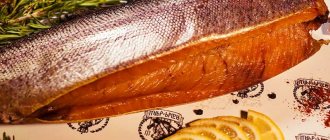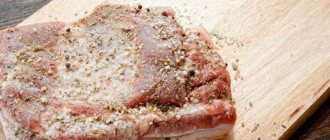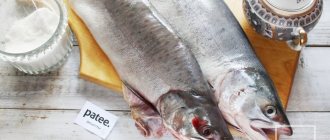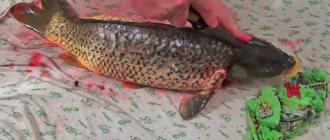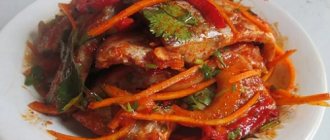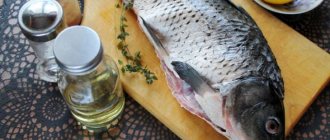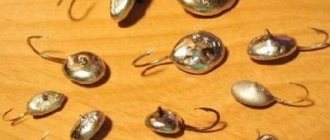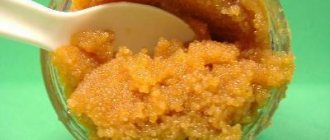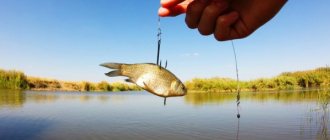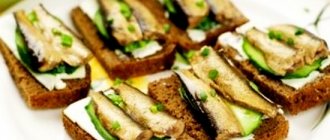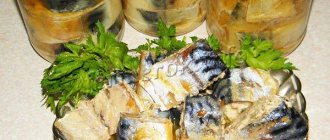Balyk from carp at home
There are many recipes that describe in detail how to make balyk from carp at home. They differ in the set of ingredients and the duration of salting and drying. Regardless of the option you choose, you will need to select the right fish and properly prepare it for cooking.
Choosing fish for balyk
All recipes for balyk from carp at home involve the use of large fish. Carp wins in this regard, since finding a large specimen will not be difficult.
You should only choose fresh fish!
Preference should be given only to fresh fish. If it has just been caught, then you can try to cook balyk directly on the field. But you can make dried product at home, even in an apartment, by placing the carp on the balcony or loggia.
What are the benefits of carp
Despite the fact that such balyk is not sold in stores, even professionals recommend it for home preparation.
This is due to the following points:
- there is a lot of meat in the carcass, and it has an original taste;
- There are few bones in carp, they are large and therefore easy to remove;
- the fish practically does not absorb the smell of mud, so there is no river smell.
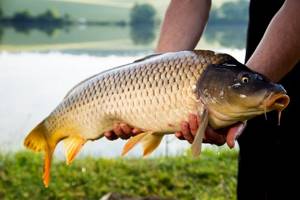
Meaty fish with minimal bones
Balyk from carp turns out to be very nutritious and aromatic. The individual has a reddish color of meat, so its taste and appearance may resemble a product made from red fish.
How to properly clean and cut fish
It’s easy to prepare balyk from carp at home following the recipe. But the key to an ideal result is the correct cutting of the fish. The following set of tools will greatly facilitate this stage:
- scale cleaner;
- large knife;
- hatchet;
- kitchen scissors or pruning shears.
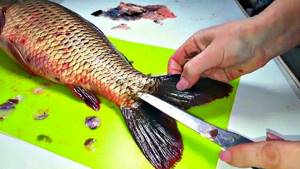
Cutting is carried out according to the following algorithm:
- The head and tail are removed. They can be used to prepare the first dish. From carp, pike perch, catfish, ukha turns out to be aromatic and tasty.
- The remaining fins are trimmed.
- The peritoneum is cut and the entrails are removed.
- The inner surface is washed from blood, the black film is removed.
- Wipe the surface with paper napkins or towels.
- An incision is made along the ridge.
- The carcass is flattened, starting from the tail.
- Trim ribs that have not separated from the backbone. They should remain in the carcass.
- The fillet is cut into pieces of 2-4 centimeters. The abdominal part is rolled into a roll.
Preparing carp is a meticulous process, but following simple recommendations it is easy to cope with. Cutting doesn't take much time. After drying the pieces, you can proceed to the next step.
What kind of fish goes for balyk
Any large fish whose meat has high and medium fat content is considered suitable for preparing balyk. Fatty fish with a small number of small fork bones is prized, but balyk can be made from almost any fish of sufficiently large size.
The most popular types of fish from which delicious balyk is made are asp, silver carp, catfish and carp. Balyk made from sturgeon and red fish from the salmon family will be very tasty. The fattest fish will be any fish caught in the autumn and early winter.
We invite you to read: Secrets of catching carp in winter
List of fish that make delicious balyk, grouped by popularity:
- Asp, ide, chub, bream;
- Silver carp;
- Catfish;
- Carp, carp, crucian carp;
- Mackerel, mackerel, tuna;
- Pike, zander;
- Chum salmon, pink salmon, trout, omul, whitefish, nelma, salmon;
- Sturgeon and sturgeon species of fish.
There is a fish on this list that cannot be considered a boneless fish and is not a fatty fish, but this does not mean that it cannot be used to make balyk. There will always be lovers of dietary lean meat, for example, pike or pike perch in the form of balyk.
The asp is at the top of this list not because it makes the most delicious balyk, but because it more often ends up in the hands of the fisherman as a trophy. This is a rather bony fish, and when the question arises of how to cook it, two options come to mind: mince it and fry the cutlets, or make balyk and then deal with the bones - it is much more convenient to do this in dried fish than in cooked in a different way.
The fish from which balyk is prepared can be divided by size into medium, large and very large. Medium-sized fish is used for balyk almost entirely, and large ones undergo preliminary cutting - it is divided into tesha and the balyk itself. Very large fish is cut into pieces.
Balyk recipes from carp
Any recipe for balyk involves salting and drying. The first stage differs in duration, depending on the preference for the salinity of the product. The timing of the second stage determines what kind of balyk you will get, dry or juicy. The product can be made according to a traditional recipe or use an original algorithm.
Classic recipe
This technology involves dry salting. To make balyk from carp according to this recipe, you will need:
- coarse salt;
- sugar;
- spices to taste.

The second component is optional. It gives the product a sweetish taste and also helps the salt penetrate deeper into the fibers.
The delicacy is prepared as follows:
- Pieces of carp are dipped in salt and seasonings, and a layer of fish is placed in a container.
- The fish is placed under pressure and sent to the refrigerator for 3 days.
- The fillet is periodically turned over so that the entire surface is in contact with the released juice. Salted fish will become tough. If the pieces are soft, you can leave the product in the refrigerator for another 2 days.
- The carp is soaked in water for 2-3 hours. After this, the surface is dried with napkins or paper towels.
- The workpiece is placed in the freezer for 1 day. This will destroy harmful microorganisms, if any.
- Hang the pieces on a rope and hang them to dry. The room should be well ventilated. The duration of this stage is 2-3 days. Prolonged drying will make the product dry.
- Wrap the balyk in parchment paper and place in the refrigerator for 2 days to ripen.
If the product is not served immediately, it is stored at home in the refrigerator, wrapped in parchment paper.
Carp delicacy
An original delicacy is made from carp, which after cooking is ready to serve. To do this, you will need to gut the fish and remove the skin. Then the fillet is cut into pieces no larger than 2 cm. The pieces are rolled in salt and spices.
Seasonings are selected according to taste, but experts recommend using ground pepper and suneli hops with carp. They give homemade products an exquisite aroma and taste. This dish does not need to be put under pressure. The meat is sent to the refrigerator in the form of rolls, twisted from small pieces. The duration of salting depends on the amount of meat. For a small carcass, 3-4 days will be enough; for a large number of fillets, it will take about 1 week. The pieces of carp are turned over 2-3 times a day.
The next step will be freezing. The meat, washed from spices, is left in a container in the freezer for 2 days to kill germs and parasites. This procedure can be carried out both before and after salting.
The final stage of home cooking is drying. Pieces of fillet are strung on a rope and hung in the sun for 3-4 hours. During this time, an appetizing crust forms on the surface. Then the fish is placed in a well-ventilated area and left for another 3-7 days.
The product is ready to use. It will also become an original component of other homemade dishes. It must be stored in the refrigerator wrapped in paper. The shelf life is about a week.
How to select and cut fish
When choosing a carp, you need to adhere to traditional subtleties that will help distinguish a high-quality carcass that has not been frozen many times from spoiled meat. These selection rules include:
- Gill color
. In fresh fish they are bright, but this rule only works for chilled fish. Frozen carp's gills lose their color. - Eye condition
. For both chilled and frozen fish, they should be clear, light, without turbidity. - Skin condition
. The carcasses are uniform, with even scales, elastic and not loose. - Smell
. If, after defrosting, the carp smells faintly of river mud or the sea, then this is its normal condition. An overly strong smell with obvious notes of rot indicates that the fish was frozen in a stale state.
After choosing and purchasing the right product, you can begin preparing it for smoking at home.
Preparing and cutting fish
Before cutting and salting carp, you need to defrost it properly. Do this slowly, putting the fish in the refrigerator and removing it only just before cooking. If there is absolutely no time, speed up the defrosting process by placing the carcass in cold water.
Next, proceed to cutting:
Gut the carp from the ridge side, making an incision along the fins and removing the insides. If you have no experience in cutting fish, then you can perform the classic technique by cutting the belly and removing the entrails through it.
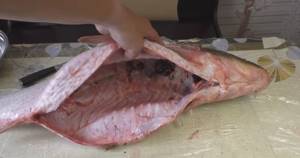
The gills and head of large fish are cut off, and small ones are smoked along with them, but washed longer and more thoroughly.
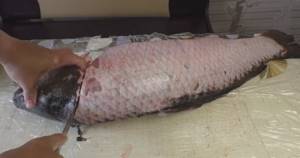
The scales of carp are quite large; they can be removed before cold smoking.
However, many cooks save it to protect meat from exposure to carcinogens from smoke.
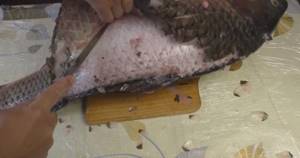
After removing organs and excess elements, the carcasses are washed, you can use a brush to better remove blood and mucus.
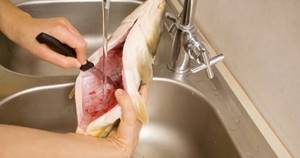
Important! Further preparation for salting is carried out based on one’s own preferences: the fish is cut into pieces, also removing all the fins along with the tail, or left as beautiful large carcasses if the size of the smokehouse allows cooking a whole carp.
In addition to cutting into pieces, you can smoke carp by cutting it into fillets, removing bones and other unnecessary parts.
Useful tips from chefs
To improve the taste of the product at home and make it safe, professionals recommend:
- Dry fish in autumn. At this time there are fewer insects and environmental conditions are ideal for drying.
- If an individual has eggs, they need to be carefully pulled out. You can fry it or make delicious cutlets.
- If insects fly onto the product, you can pre-moisten the gauze in vinegar. This will repel flies and other parasites.
- To obtain a pleasant aroma, you can use a smoker. In its absence, a few drops of liquid smoke will make the dish aromatic.
Each chef has his own secrets for preparing balyk from carp. At home, you can create your own recipe, according to which the product will turn out tasty, beautiful and aromatic.
Dried fish is distinguished by its piquancy and is considered a luxurious table decoration. By making the delicacy yourself, you will not only be able to save money, but also tailor the dish to your personal taste requirements.
Dried carp straws
This is a delicious snack. It is eaten even by those who do not like the taste of dried and dried fish.

1 kg of dried carp straws in the store costs more than one thousand rubles. An undeniable convenience is vacuum packaging, which preserves taste and freshness for a long time.
It is more profitable and easier to prepare the straws yourself. You won't have to worry about long-term storage. It is so tasty that it is quickly eaten. It's nice to just have a snack when you feel hungry. Beer lovers find special use for it.
Straws are easy to make from any type of fish.
Making straws from dried carp
Take dried (semi-finished) dried fish. The spine is removed from it if this is not done before drying. The ribs and small bones are left - they will practically not be felt as a hindrance. But you can remove them if they annoy someone. Using a sharp knife, the fillet is cut along the backs into long and thin strips.
Then the straws are placed on large plates in a heap, without pressing or compacting. And dry to a pleasant condition. Store in paper bags in small containers.
